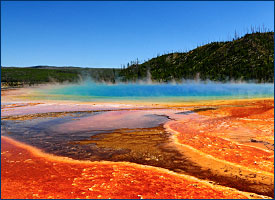Preserving Sustainable Resources
Biological Miracles and Ecological Faith in the Future — Part 3
Preserving Sustainable Resources: Dancing Star Foundation Missions
Those at Dancing Star Foundation believe that all life is precious; that animal rights is most magnificently displayed in two specific arenas: among individuals, and at levels of vast habitat protection, such as at the Greater Yellowstone Ecosystem (over 20 million acres) or the largest single national park in America, Wrangell-Saint Elias, overlooking the Lost Coast of Alaska, as well as encompassing vast sections of the South-Central Interior of that state.
 Engaging in both the protection of forests, as well as the individual trees, has been hard for many to reconcile. Add to this compounding dilemma of protections the unwieldy ecological footprint of 6.8 billion people, soon to become nearly 10 billion or more, with all of their consumer habits, and the options for environmental hope grow dimmer by the moment.
Engaging in both the protection of forests, as well as the individual trees, has been hard for many to reconcile. Add to this compounding dilemma of protections the unwieldy ecological footprint of 6.8 billion people, soon to become nearly 10 billion or more, with all of their consumer habits, and the options for environmental hope grow dimmer by the moment.
Yet, think of all those who have brought beauty, human beauty, to the world; people like Mozart, Monteverdi, Beethoven, Da Vinci, Shelley, Corot, George Inness, John Hay, Aldo Leopold, Thoreau, Bach, Vermeer, Stanley Kunitz, Han-Shan, Kuo His, the countless brave souls struggling to save what’s left in all the 35 terrestrial hotspots. These are personal pillars of hope and received wisdom throughout time and we must acknowledge them, pay our respects and — most importantly — try day and night to follow in their footsteps.
At the Dancing Star Foundation animal sanctuaries in California as well as New Zealand, we are trying to do both: to protect rescued animals and provide true sanctuary for them, while also focusing on the wild creatures. Maintaining a balance between the two is never an easy proposition. In island nations like New Zealand, endemic species were absolutely unequipped by evolution to cope with the sudden onslaught of non-native carnivores and omnivores. In continental North America, biological carrying capacity ordains cycles of native grass species given to x-number of herbivores; the compaction of soil; and the necessity for (unnatural) human intervention which by definition equates with the animal rights conundrum, namely, sanctuary ethics, and how to best ensure long, dignified natural life spans for animals who would, otherwise, cease to exist outside the sanctuary confines.
Part 2: The Values of Conservation
Part 1: Is Conservation Achieving It’s Goals? (the beginning)
Comments Off
